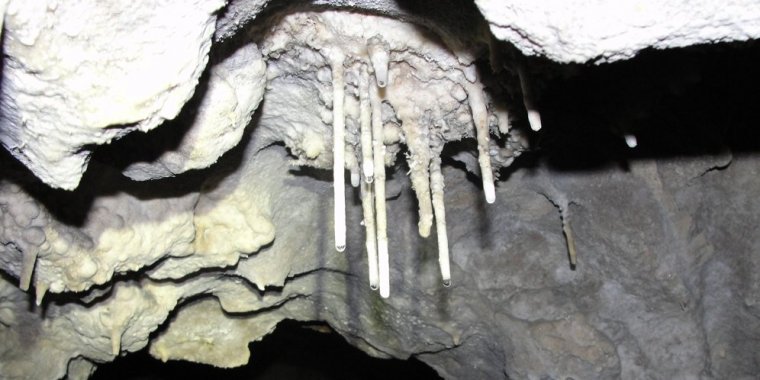| News / Science News |
Cave stalagmites reveal India’s rainfall secrets
Stalagmites in a remote cave in northeast India hold climate secrets that can help predict rainfall patterns, floods and droughts in the sub-continent.

“Soda straw” formations dripping water from the ceiling of a cave in Meghalaya. Photo: Chris Myers/SciDev.Net
The findings of the study suggest a connection between winter rainfall in India’s northeast region and climatic conditions in the distant Pacific Ocean.
India, a predominantly agricultural country, has some 60 per cent of its total sown area under rainfed farming, making scientific forecasts of rainfall patterns vital to the country’s economy.
Researchers examined the last 50 years’ growth of a stalagmite in the Mawmluh cave of India’s Meghalaya state. The northeastern state shares a border with Bangladesh and is considered among the world’s wettest places for the heavy rainfall it receives.
Stalagmites are cave pillars made largely of calcium carbonate or limestone, in association with trace elements such as magnesium, that is precipitated by rainwater.
“As a stalagmite grows, it records the chemistry of the water that has percolated from the surface to the cave [ceiling] and which ultimately drips on to the stalagmite,” says Elli Ronay, study researcher from the department of earth and environmental sciences, Vanderbilt University, US.
As the water percolates from the surface through the soil and rock layers of the cave, the chemistry of the precipitation changes in a way that is primarily dependent on the amount of water flowing through the cave system.
The summer and winter magnesium-to-calcium ratios are thus very different from each other due to variations in the quantity of water entering the cave during these seasons.
“In this stalagmite, we interpret an increase in winter rainfall that coincided with an observed change in sea surface temperature patterns in the North Pacific Ocean,” says Ronay. The study notes that this distant link between land and ocean records could aid in predicting the dry season (winter) rainfall amounts in northeast India and help farmers.
The stalagmites were found to be more sensitive to changes through winter rainfall than summer monsoon. This is an unexpected finding because many of the earlier records were based on the idea that only summer monsoon rainfall was recorded by these minerals.
Young stalagmite material built up quickly, enabling the study of rainfall patterns over the last 50 years. The stalagmite data was compared with recorded information on rainfall in northeast India and other aspects of climate worldwide.
“This brings into focus relationships between northeast Indian rainfall and other global climate patterns — such as the Pacific Decadal Oscillation that may otherwise be difficult to see — that could really help us understand how and why rainfall has changed recently” Oster says. (SciDev.Net)
YOU MAY ALSO LIKE




